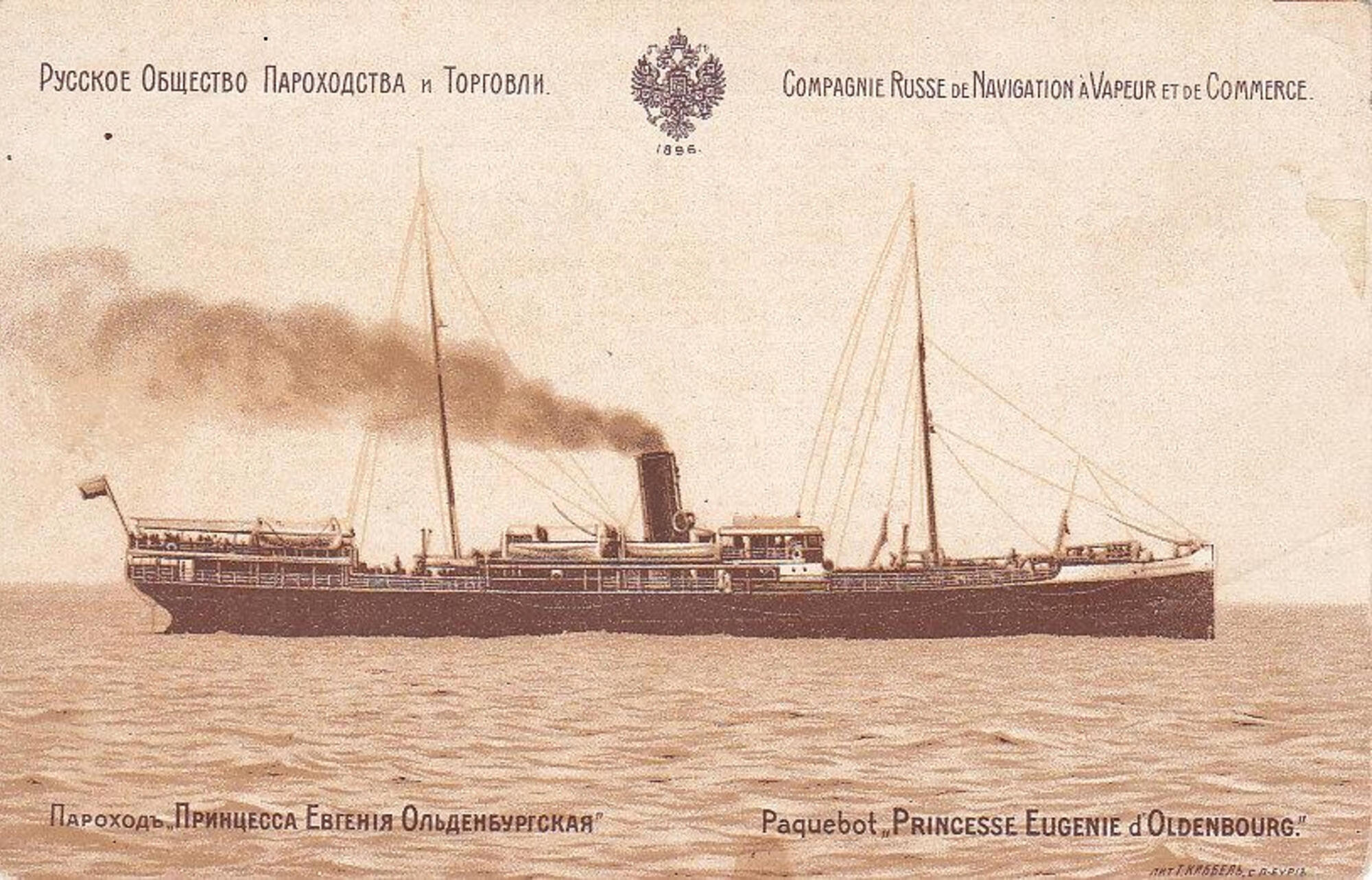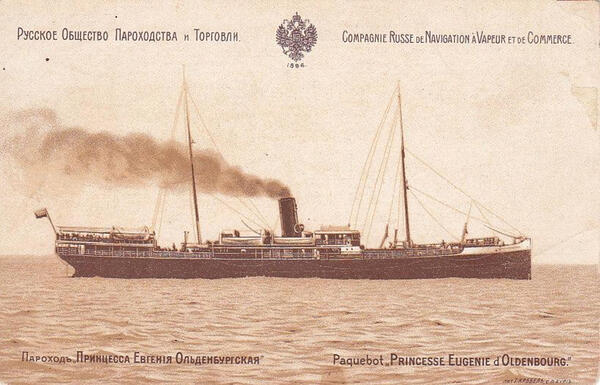The front side of the postcard depicts the steamer ‘Princess Eugenia of Oldenburg.’ In the center of the upper edge, the coat of arms of the Russian Empire of 1896 is imprinted. There are inscriptions in Russian and French on both sides of the coat of arms: ‘The Russian Society of Shipping and Trade’.
The ‘Princess’ was at the disposal of the shareholders of the ‘Russian Society of Shipping and Trade’, the main office of which was located in Odessa. The company provided commercial and passenger voyages on domestic and international shipping lines. Thanks to its activities, excursion tourism in the Crimea and the Caucasus was developed, an interest in pilgrimage to the holy places of Palestine and Athos increased as well. In 1910, the Russian Society of Shipping and Trade organized an unusual advertising campaign to promote domestic products to the Mediterranean markets. 135 Russian firms rented space for exhibiting their goods on the ship ‘Emperor Nicholas II’. That floating exhibition made a two-month cruise in almost two dozen port cities and caused a great stir.
The steamer ‘Princess Eugenia of Oldenburg’ worked on the Crimean-Caucasian passenger line, made voyages to the ports of the Mediterranean Sea. Its length was 81.1 meters, width - 11 meters. It could take 290 people on board. Admittedly, the ship’s speed was not very high - 12 knots per hour.
In 1911, on New Year’s Eve at the entrance to the Dardanelles, the steamer Tsar ran aground with 900 Muslim pilgrims on board. ‘Princess Eugenia of Oldenburg’ that was following from Alexandria and was nearby at the time of the incident hurried to the rescue. As a result, the ‘Tsar’ was raised from the shallow. The popular pre-revolutionary newspaper ‘Russian Word’ wrote about that.
The ‘Princess’ cruised the seas until World War I. During the hostilities, the ship was sunk by the German cruiser ‘Goeben.’ But the history of the ship did not end there. After the revolution, it was raised from the bottom and repaired. The rebuilt liner was named Chicherin, after the famous Soviet diplomat. The second life of the steamer lasted until 1941. On October 15, it and several other ships were sunk to the bottom at the entrance to the Odessa port, since it was impossible to get them out of the city, but they could block the path of German ships.
The ‘Princess’ was at the disposal of the shareholders of the ‘Russian Society of Shipping and Trade’, the main office of which was located in Odessa. The company provided commercial and passenger voyages on domestic and international shipping lines. Thanks to its activities, excursion tourism in the Crimea and the Caucasus was developed, an interest in pilgrimage to the holy places of Palestine and Athos increased as well. In 1910, the Russian Society of Shipping and Trade organized an unusual advertising campaign to promote domestic products to the Mediterranean markets. 135 Russian firms rented space for exhibiting their goods on the ship ‘Emperor Nicholas II’. That floating exhibition made a two-month cruise in almost two dozen port cities and caused a great stir.
The steamer ‘Princess Eugenia of Oldenburg’ worked on the Crimean-Caucasian passenger line, made voyages to the ports of the Mediterranean Sea. Its length was 81.1 meters, width - 11 meters. It could take 290 people on board. Admittedly, the ship’s speed was not very high - 12 knots per hour.
In 1911, on New Year’s Eve at the entrance to the Dardanelles, the steamer Tsar ran aground with 900 Muslim pilgrims on board. ‘Princess Eugenia of Oldenburg’ that was following from Alexandria and was nearby at the time of the incident hurried to the rescue. As a result, the ‘Tsar’ was raised from the shallow. The popular pre-revolutionary newspaper ‘Russian Word’ wrote about that.
The ‘Princess’ cruised the seas until World War I. During the hostilities, the ship was sunk by the German cruiser ‘Goeben.’ But the history of the ship did not end there. After the revolution, it was raised from the bottom and repaired. The rebuilt liner was named Chicherin, after the famous Soviet diplomat. The second life of the steamer lasted until 1941. On October 15, it and several other ships were sunk to the bottom at the entrance to the Odessa port, since it was impossible to get them out of the city, but they could block the path of German ships.



